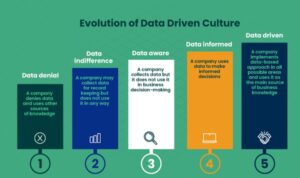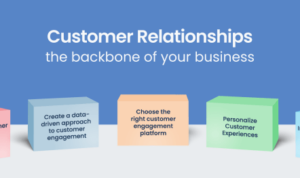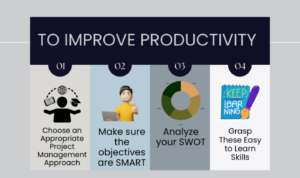Understanding Customer Journey is like navigating a maze of consumer behavior, where businesses strive to decode patterns and preferences for a successful marketing journey. From uncovering pivotal touchpoints to implementing data-driven strategies, this topic dives deep into the essence of customer engagement in today’s dynamic market landscape.
Importance of Understanding Customer Journey
Understanding the customer journey is crucial for businesses to ensure they meet the needs and expectations of their customers throughout the entire buying process.
Improved Customer Satisfaction
- By deeply understanding the customer journey, businesses can identify pain points and areas of improvement, leading to enhanced customer satisfaction.
- Companies that prioritize understanding their customers’ journey often see an increase in customer loyalty and retention.
Optimized Processes
- Companies like Amazon and Zappos have successfully optimized their processes by understanding their customers’ journey, resulting in streamlined operations and improved efficiency.
- By mapping out the customer journey, businesses can better allocate resources and provide personalized experiences, ultimately driving growth and profitability.
Targeted Marketing Strategies
- Understanding the customer journey allows businesses to tailor their marketing strategies to specific touchpoints, ensuring relevant and timely communication with customers.
- Companies like Spotify and Netflix leverage customer journey insights to deliver personalized recommendations and targeted promotions, increasing engagement and conversions.
- During the awareness stage, customers become aware of a business or brand through various channels such as social media, advertising, or word of mouth.
- Key touchpoints in this stage include social media ads, influencer marketing, and online reviews.
- Businesses can enhance the customer experience in this stage by providing valuable content, engaging with customers on social media, and offering incentives for further engagement.
- Once customers are aware of the business, they move to the consideration stage where they evaluate the products or services offered.
- Key touchpoints in this stage include product reviews, comparison websites, and customer testimonials.
- Businesses can tailor their approach by providing detailed product information, offering demos or trials, and showcasing customer success stories.
- In the decision stage, customers are ready to make a purchase and choose a specific product or service.
- Key touchpoints in this stage include pricing, promotions, and customer support.
- Businesses can enhance the customer experience by offering seamless purchasing processes, personalized recommendations, and excellent customer service.
- After making a purchase, customers enter the post-purchase stage where they evaluate their experience and decide whether to become repeat customers.
- Key touchpoints in this stage include follow-up emails, surveys, and customer feedback.
- Businesses can tailor their approach by showing appreciation, providing ongoing support, and offering loyalty rewards to encourage repeat business.
- Mapping out the customer journey is essential for effective marketing campaigns as it helps businesses understand the needs and preferences of their customers at each stage.
- By identifying key touchpoints and pain points in the customer journey, businesses can create targeted marketing strategies that resonate with their target audience.
- Understanding the customer journey allows businesses to improve customer engagement, increase customer loyalty, and ultimately drive business growth.
- Implement surveys, feedback forms, and reviews to gather customer insights.
- Analyze feedback data to identify trends, common issues, and areas for improvement.
- Use customer feedback to make informed decisions on product development, service enhancements, and overall customer journey optimization.
- Regularly track key performance indicators (KPIs) related to the customer journey.
- Conduct periodic reviews of customer feedback and make necessary adjustments to improve the overall experience.
- Stay agile and responsive to changing market trends and customer demands to ensure ongoing success.
Stages of the Customer Journey
In the customer journey, there are several key stages that a consumer goes through before and after making a purchase. Understanding these stages is crucial for businesses to tailor their approach and enhance the overall customer experience.
Awareness Stage
Consideration Stage
Decision Stage
Post-Purchase Stage
Significance of Mapping Out the Customer Journey
Tools and Techniques for Understanding Customer Journey
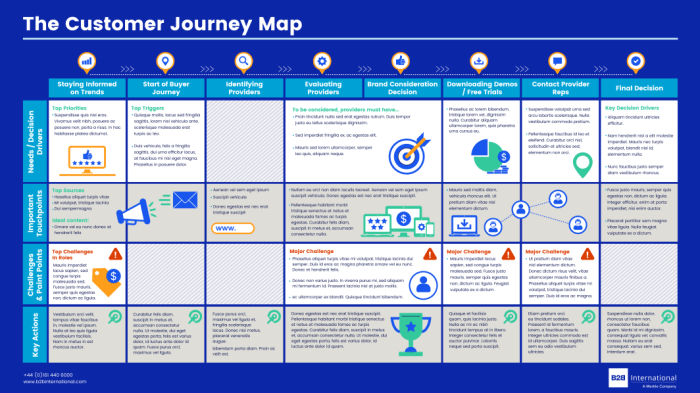
Understanding the customer journey is crucial for businesses looking to improve their products and services. By utilizing various tools and techniques, companies can gain valuable insights into customer behavior and preferences.
Customer Journey Maps
Customer journey maps are visual representations of the steps a customer takes when interacting with a company. This tool helps businesses understand the customer experience from start to finish, identifying pain points and areas for improvement.
Analytics Software, Understanding Customer Journey
Analytics software allows businesses to track and analyze customer interactions at different touchpoints. By collecting data on customer behavior, preferences, and purchasing patterns, companies can tailor their marketing strategies to better meet customer needs.
Surveys
Surveys are a direct way to gather feedback from customers about their experiences with a product or service. By asking targeted questions, businesses can uncover valuable insights into customer satisfaction and areas for improvement.
Data Analytics
Data analytics plays a crucial role in understanding customer behavior. By analyzing data collected from various sources, businesses can identify trends, patterns, and correlations that provide valuable insights into customer interactions.
Best Practices for Collecting and Analyzing Data
To gain a comprehensive understanding of the customer journey, businesses should follow best practices for collecting and analyzing data. This includes setting clear objectives, using reliable data sources, and leveraging advanced analytics tools.
Technology for Tracking Customer Interactions
Businesses can leverage technology to track customer interactions across multiple channels. By utilizing customer relationship management (CRM) software and other tracking tools, companies can monitor customer engagement and tailor their marketing efforts accordingly.
Implementing Insights from Customer Journey Analysis: Understanding Customer Journey
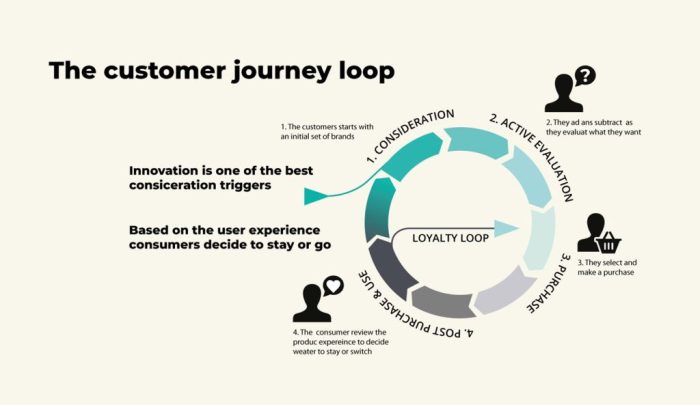
Customer journey analysis provides valuable insights that can help businesses improve their products or services. By understanding the different stages of the customer journey, companies can identify pain points, preferences, and areas for enhancement. Here are some steps on how businesses can use insights from customer journey analysis to enhance their offerings:
Utilizing Customer Feedback for Refinement
Customer feedback plays a crucial role in refining the customer journey. By collecting and analyzing feedback from various touchpoints, businesses can gain valuable insights into customer preferences, expectations, and satisfaction levels. This feedback can help identify areas of improvement and guide decision-making processes to enhance the overall customer experience.
Successful Implementation by Companies
Several companies have successfully implemented changes based on customer journey analysis, leading to improved customer satisfaction and loyalty. For example, Amazon utilizes customer data to personalize recommendations and enhance the shopping experience. Similarly, Starbucks revamped its mobile app based on customer feedback to streamline ordering processes and improve convenience.
By leveraging insights from customer journey analysis, companies can tailor their offerings to meet customer needs and expectations, ultimately driving business growth and success.
Continuous Monitoring and Adjustment
It is essential for businesses to continuously monitor and adjust their strategies based on customer journey insights. Customer preferences and behaviors evolve over time, requiring companies to adapt and refine their approaches to stay competitive and relevant in the market.

